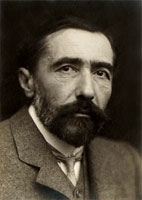On this, the last day of my month of blogging about the Titanic every day, I want to share with you the story of these shoes.
These tiny shoes (the scale is centimeters) are believed to belong to The Unknown Child, a very young boy whose body was recovered by the Mackay-Bennett crew in 1912.This is what the records say about the Unknown Child:
NO. 4. - MALE. - ESTIMATED AGE, 2. - HAIR, FAIR. CLOTHING - Grey coat with fur on collar and cuffs; brown serge frock; Brown Petticoat; flannel garment; pink woollen singlet; brown shoes and stockings.
No relatives came to claim the shoes--or identify the body. Possibly, close relatives had all perished in the wreck.
Most of the clothing and other items recovered by the Mackay-Bennett crew were burned to stop souvenir hunters. But the Halifax police sergeant who helped guard over the belongings could not bring himself to burn the tiny shoes. He put them in his desk drawer. Eventually, they were given to the Maritime Museum of the Atlantic.
The child's remains were eventually mis-identified, and then re-identified . . . a touching ceremony was held at the graveside:
A cousin read the names of about 50 children who had also perished when the Titanic went down and a bell was rung for each, she said.
A soft, drizzling rain began to fall as the first name was read, and stopped when the list was finished, she recalled. Ultimately, the family left the headstone and the grave as it was.
"The tombstone of the unknown child represents all of the children who perished on the Titanic, and we left it that way," she said.













,_October_2009.JPG/220px-Belfast_(111),_October_2009.JPG)